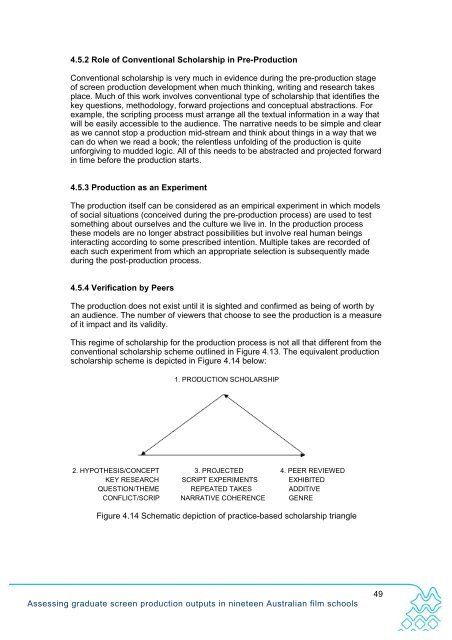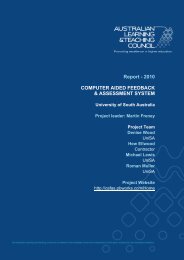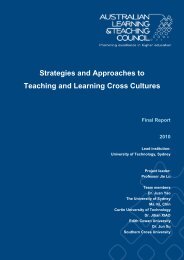Assessing graduate screen production outputs in nineteen ...
Assessing graduate screen production outputs in nineteen ...
Assessing graduate screen production outputs in nineteen ...
You also want an ePaper? Increase the reach of your titles
YUMPU automatically turns print PDFs into web optimized ePapers that Google loves.
4.5.2 Role of Conventional Scholarship <strong>in</strong> Pre-ProductionConventional scholarship is very much <strong>in</strong> evidence dur<strong>in</strong>g the pre-<strong>production</strong> stageof <strong>screen</strong> <strong>production</strong> development when much th<strong>in</strong>k<strong>in</strong>g, writ<strong>in</strong>g and research takesplace. Much of this work <strong>in</strong>volves conventional type of scholarship that identifies thekey questions, methodology, forward projections and conceptual abstractions. Forexample, the script<strong>in</strong>g process must arrange all the textual <strong>in</strong>formation <strong>in</strong> a way thatwill be easily accessible to the audience. The narrative needs to be simple and clearas we cannot stop a <strong>production</strong> mid-stream and th<strong>in</strong>k about th<strong>in</strong>gs <strong>in</strong> a way that wecan do when we read a book; the relentless unfold<strong>in</strong>g of the <strong>production</strong> is quiteunforgiv<strong>in</strong>g to mudded logic. All of this needs to be abstracted and projected forward<strong>in</strong> time before the <strong>production</strong> starts.4.5.3 Production as an ExperimentThe <strong>production</strong> itself can be considered as an empirical experiment <strong>in</strong> which modelsof social situations (conceived dur<strong>in</strong>g the pre-<strong>production</strong> process) are used to testsometh<strong>in</strong>g about ourselves and the culture we live <strong>in</strong>. In the <strong>production</strong> processthese models are no longer abstract possibilities but <strong>in</strong>volve real human be<strong>in</strong>gs<strong>in</strong>teract<strong>in</strong>g accord<strong>in</strong>g to some prescribed <strong>in</strong>tention. Multiple takes are recorded ofeach such experiment from which an appropriate selection is subsequently madedur<strong>in</strong>g the post-<strong>production</strong> process.4.5.4 Verification by PeersThe <strong>production</strong> does not exist until it is sighted and confirmed as be<strong>in</strong>g of worth byan audience. The number of viewers that choose to see the <strong>production</strong> is a measureof it impact and its validity.This regime of scholarship for the <strong>production</strong> process is not all that different from theconventional scholarship scheme outl<strong>in</strong>ed <strong>in</strong> Figure 4.13. The equivalent <strong>production</strong>scholarship scheme is depicted <strong>in</strong> Figure 4.14 below:1. PRODUCTION SCHOLARSHIP2. HYPOTHESIS/CONCEPT 3. PROJECTED 4. PEER REVIEWEDKEY RESEARCH SCRIPT EXPERIMENTS EXHIBITEDQUESTION/THEME REPEATED TAKES ADDITIVECONFLICT/SCRIP NARRATIVE COHERENCE GENREFigure 4.14 Schematic depiction of practice-based scholarship triangle<strong>Assess<strong>in</strong>g</strong> <strong>graduate</strong> <strong>screen</strong> <strong>production</strong> <strong>outputs</strong> <strong>in</strong> n<strong>in</strong>eteen Australian film schools49
















